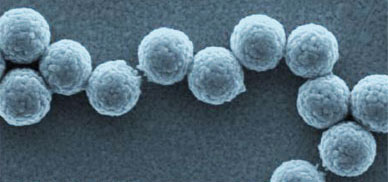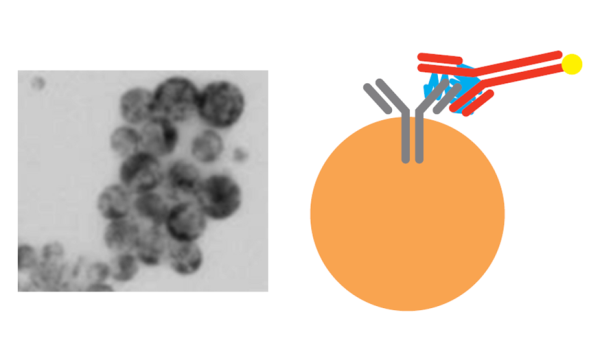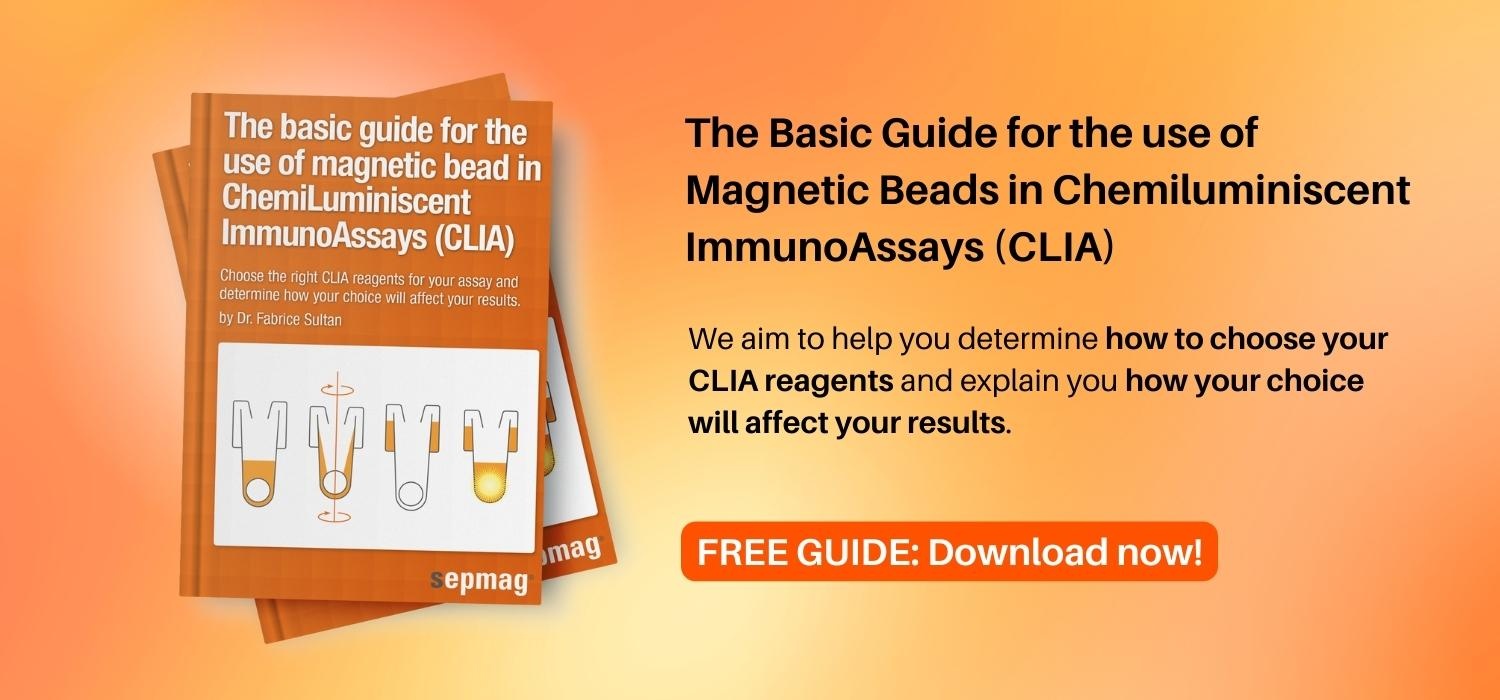Chemiluminescent immunoassays (CLIAs) are excellent assays for high-throughput, low analyte concentration and time sensitive testing and isolation. Using coated magnetic beads, such as streptavidin beads, as the reagent in a CLIA is an easy and established technique favored among many clinical scientists.
This post is about using magnetic beads, such as streptavidin beads, in Chemiluminescent immunoassays. If you are interested in this topic, download our free ebook The Basic Guide for the use of Magnetic Bead in Chemiluminescent immunoassays:
Whether you decide to use the one-step sandwich technique or the two-step immunocapture technique, the magnetic beads used in your assay will be attached to an antibody that is highly specific or sensitive to your analyte. The sandwich technique involves mixing your biosample with the coated magnetic bead reagent and then with a secondary antibody that is conjugated to a stable enzyme. After final washing and reaction with substrate, the level of chemiluminescence in the solution is determined.
Immunocapture is used when theanalytes are also antibodies. The coating on the magnetic beads is specific to the antibody analyte and ‘captures’ the desired antibody in your biosample. The sample is washed extensively and is then mixed with an enzyme-conjugated anti-analyte antibody.
Thus, in this CLIA, you will be using two separate anti-analyte antibodies, one of which is coated onto your magnetic beads and the other of which is conjugated to a reactive colorimetric enzyme. The mixture is washed and reacted with substrate. In both of the above assays, the level of chemiluminescence is proportional to the concentration of analyte in the biosample.
Designing a successful CLIA with streptavidin beads

Making sure the CLIA you develop is accurate and consistent will be key for creating a high demand detection product. In order to develop the best product possible, it is important that you consider all of these steps:
1. Make sure you know the expected concentration range of your analyte and make sure you understand the assay specimen type.
2. Choose antibody type. Use polyclonal antibodies if your epitopes are not well defined and choose monoclonal antibodies if you have a well defined epitope and need very high specificity. Polyclonal antibodies are not specific for one epitope but tend to recognize the range of epitopes ‘seen’ by the immune system.
3. Choose the proper magnetic bead for your particular assay. Be sure to consider all of the following variables:
- Bead size (try to work with medium-sized beads, around 1.0 um if possible).
- Bead material (PS or PS/DVB, other types of materials or encapsulated if possible)
- Beads with a higher magnetic pigment content ( between 30% and 50% if possible).
- Bead surface properties (plain, modified, pre-activated or bio-activated)
- Bead batch size
- Bead ‘a la carte’. If what you need are not available as standard product, ask your supplier to develop a custom product to fit your specific needs.
4. Think carefully about the bead surface you need for your assay. While plain surfaces are the cheapest and are the easiest to work with, they also can have specificity problems and high background readings. Modified surfaces (typically modified with carboxyl or amino gropus) will stably couple, but require chemical activation that can cause aggregation. Pre-activated surfaces (usually with tosyl groups) are easy to couple and bio-activated surfaces are usually free from background noise (although a very expensive modification). Encapsulated beads improve your assay’s sensitivity and stability. Encapsulated beads are usually modified with either carboxyl or amino groups.
5. Some magnetic bead types are used more than others. You may want to consider the well-used, well-established beads or decide that you need unique modifications.
6. Make sure you test the stability of your reagent and aim to address short term, long term and real-time stability issues. In addition, pay attention to storage conditions, hot/cold cycles and delivery when considering stability of your beads. Stability issues can cause wide variation in accuracy from one assay to another. The best reagent is one that is refractory not only to conditions it will encounter in your lab, but also to conditions it may encounter during shipping. Your final product will be more valuable to the end user if stability can be maintained in adverse and normal conditions over long periods of time.
7. Blocking reagents are important for dramatically reducing non-specific background and auto-aggregation in immunoassays. Test a variety of different blocking reagents and choose the blocking reagent that gives the least background noise and stability. The performance of one blocking reagent may vary with different analytes, so it is vital that you know which blocker will work best with your analyte and specific magnetic beads.
8. Make sure you have vetted your magnetic bead supplier thoroughly before beginning your development. Ask specific questions about the production of their product, how the product is delivered and how they guarantee their product. Know if the supplier can produce custom products as well in case you anticipate future development of specific reagents.
By following all of these steps, your CLIA assays that use magnetic bead technology will be of high quality and will have a much better chance of becoming high demand products.
Don't forget to check these posts from our blog in order to get a deeper insight into Chemiluminescent immunoassays:
- Chemiluminescent Immunoassays for easy and safe analyte detection
- The Two Key Reasons for Selecting Chemiluminescence for Immunoassays
- How Do Chemiluminescent Assays Work?





